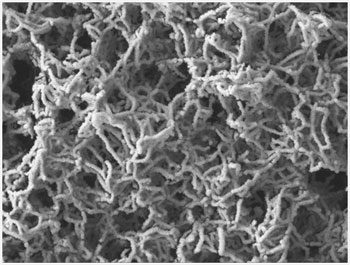Enhanced carbon nanotubes detect molecules at trace amounts
November 13, 2013
Scientists have come up with yet another innovative use of nanotubes: to detect molecules at extremely low concentrations, making it possible to detect trace amounts of toxic biological warfare agents, explosives, and drugs.
The joint research team at Lawrence Livermore National Laboratory (LLNL) and the Swiss Federal Institute of Technology (ETH) in Zurich is using three innovative techniques to achieve this:
1. Surface-enhanced Raman spectroscopy (SERS), a technique that helps reduce the effects of scattering of photons by molecules adsorbed on rough metal surfaces and nanostructures.

The top view of the jungle canopy, which is most effective at hafnium thickness of 2.5 nanometers and gold thickness of 20 nanometers (credit: Lawrence Livermore National Laboratory)
2. Gold-coated carbon nanotubes (CNTs) bunched together like a jungle canopy to amplify the signals of both the incident and Raman scattered light by exciting local electron plasmons.
3. An intermediate dielectric coating (hafnium) on the nanotubes, which blocks quenching of the free electrons.
The researchers hope their engineered material will eventually be used in portable devices to conduct on-site analysis of chemical impurities such as environmental pollutants or pharmaceutical residues in water.
Other applications include real-time point-of-care monitoring of physiological levels for the biomedical industry and fast screening of drugs and toxins for law enforcement.
Note to reader Gorden Russell: this should inspire some new ideas for enhanced carbon nanotubes! — Editor
Abstract of Advanced Materials paper
Bond and Park’s discovery was recently featured on the cover of the issue of Advanced Materials. Irradiation of a dark red laser (λ = 785 nm) on a canopy of gold-hafnia-carbon nanotubes (CNTs), supported by vertically aligned hafnia-CNTs without gold, can induce local plasmonic enhancement of the electromagnetic field at the CNT junctions by a “kissing nanowire” effect. This is demonstrated by work by Hyung Gyu Park, Tiziana Bond and co-workers on page 4431. Eliminating the quenching of surface plasmons through the CNT by the insertion of a dielectric barrier (hafnia), molecules such as 1,2bis-(4-pyridyl)-ethylene located in these hot spots can be detected at femtomolar-level concentrations by surface enhanced Raman scattering
